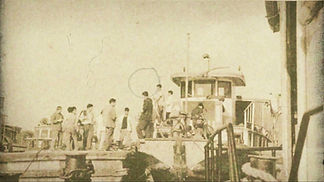The Qiantang River’s water transport has undergone three stages of transformation from 1970 to the present, tracing its journey from a lifeline of passenger ferries to a modernized freight network shaped by bridges, canals, and urbanization.

The Age of Passenger Ferries
Pre-1970s – 1980s
Before bridges spanned the Qiantang, wooden ferries served as vital connectors between Hangzhou’s north and south banks. Key crossings like Nanxingqiao and Xixing operated under the rhythms of tides and weather—slow, precarious, yet essential.
In 1937, the completion of the Qiantang River Bridge (First Bridge) introduced a railway-highway link, yet ferry traffic resurged during its wartime destruction and repair. By the 1970s, motorized ferries still served isolated island communities such as Wufeng and Wujia, running 6–8 daily trips for villagers commuting to school, markets, and clinics.

Freight Expansion & Passenger Decline
1980s – 2000s
A turning point came in 1989 with the opening of the Sanbao Ship Lock—linking the Qiantang River to the Grand Canal and Yangtze system. This spurred a freight boom: small wooden barges gave way to 50–100 ton motorized vessels transporting construction materials, coal, and grain upstream from Fuyang and Tonglu.
At the same time, new bridges—such as the Second Qiantang Bridge (1987)—diverted passenger traffic to roads and railways. Most ferry crossings were closed, leaving only a few island routes, such as Wufeng and Yuanpu, operating as small community ferry services.

Specialization & Modernization
2000s – Present
In the 21st century, upstream shipping faced challenges from hydropower dams and silted channels. However, modernization projects like the Fuchunjiang Ship Lock (2017) reopened the river to 500–1000 ton vessels, enabling seamless transport to coastal ports like Shanghai and Ningbo. Dongzhou Port emerged as a container hub, while historic piers like Wenyan evolved into tourist attractions offering sunset ferry rides.
Today, only a handful of island ferries remain—serving elderly residents and curious travelers. On the freight side, vessels are larger, crews smaller, and life aboard more connected, yet the workforce is aging, and young people rarely take up the trade.
Photographs retrieved from the Hangzhou Municipal Archives